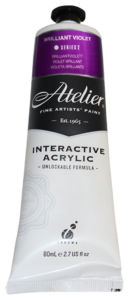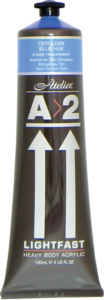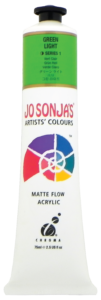(To access past newsletters, please click here.)
NOTES FROM JIM COBB ON ACRYLICS & MEDIUMS
As featured in Australian Artist Magazine - click to download the article
At Chroma all the products we make are designed to help bring out your creativity and make you a better artist. This month I'm focusing on our range of acrylics and here is where you’ll find the one information source on easy-to-do stuff you may not know about.
Stop Watching and Start Painting!
While you can watch lots of videos showing how to use acrylics you have to start using them to see how well they can work for you. As you can see from the accompanying chart understanding acrylics is not hard. All you do is mix your colours with the chosen medium that lets you work in a particular technique or to get the special effect you're looking to do. Check out a full description and the videos of what each medium can do in this expanded Newsletter and then visit your closest stockist to pick up some tubes. Most of our acrylics are available in bottles, jars and tubes.
Acrylics Will Set your Creativity FREE!
Think of acrylics as a "Swiss Army Knife" for artists. Use it to achieve almost any effect or technique. It lets you explore and express yourself in ways no other medium can.
Understanding Acrylics: The Short Story
PROFESSIONAL ARTISTS' QUALITY
AMATEUR
SPECIALITY
 ATELIER
ATELIER
Interactive
VISCOSITY:
Heavy Bodied Thick Viscosity
DESCRIPTION:
A unique acrylic which allows both traditional, fast drying techniques and longer painting sessions.
 ATELIER
ATELIER
Free Flow
VISCOSITY:
Fluid Viscosity
DESCRIPTION:
The most fluid free flow and vivid artists' acrylic in the world.
 ATELIER
ATELIER
A2
VISCOSITY:
Heavy Bodied Thick Viscosity
DESCRIPTION:
A lightfast acrylic ideal for art students and serious amateurs.
*More colours available in the USA.
 CHROMA'S
CHROMA'S
Jo Sonja's Artists' Colours
VISCOSITY:
Matte Flow Acrylic
DESCRIPTION:
A high quality acrylic for fine art and decorative art (the smooth viscosity is ideal for folk art and decorative art.)
*More colours available in the USA.
Why did we call it Interactive?
For years we have had Atelier Interactive, the only acrylic that can be kept wet for blending yet can also be dried easily for layering. This is the next step in perfecting the acrylic painting process.
Atelier Interactive is easy to keep wet for more blending - but it dries normally when you stop painting. It's interactive with your needs so that's what we called it. This is a unique feature and is a great reason to choose it over other brands. If you already use acrylics you need to experience Atelier Interactive's properties for yourself. If you are looking to start using acrylics for the first time it is the paint you want.
Mediums
Artists who use acrylic paints shy away from mediums because they have proliferated so much in numbers and become confusing – it is like trying to choose a barbecue sauce in America because there are just too many.
What has been missing has been a simple organised set of mediums to span all viscosity levels. This problem is now solved with only three painting mediums plus a Heavy Gel and a separate Holding Gel for our Flow Formula artist colours Jo Sonja and Free Flow.
Question:
Are mediums absolutely necessary to the full and successful use of acrylics? Oil paints are settled in their use – artists spread them out and they remain wet ((maybe longer than desired) and mediums are available in hierarchies which have had time to evolve.
Problem:
Acrylics do not remain wet – as soon as they are spread out on a painting their water content starts to evaporate, and be absorbed into the substrate.
Answer:
Mediums are needed to lubricate acrylic paints
It is essential to create a wet “blanket” to fight evaporation and store moisture, and it is also essential to replace water while it is being lost by spritzing with water (or preferably Unlocking Formula) and the mediums therefore need to be able to absorb the added moisture without running.
Problem Solved:
With the setting out of the simple hierarchy shown below a whole new world opens up to artists who are using Atelier Interactive or A2.
Download the Info Sheet here
There is a range of new Atelier Mediums set out from thick to thin
Simply mix your colours with one of our mediums to get the effect you want. You may not have thought about it before but there is a rhythm to your painting process. How long is a painting session for you? Is it a couple hours or is it on and off all day? Consider your painting routines to help you choose the medium that suits you. From traditional, fast drying techniques to new, longer painting sessions, we have a Medium to suit the style you want to paint in.
The new mediums being released in Australia and New Zealand at special introductory prices have been formulated in a coordinated sequence ranging from thick to thin, and should be considered as a group from which artists can choose mediums for their own purposes. I think many artists will choose more than one medium when they have the opportunity to see on video how they work, and there will be more videos to follow. Please note: I am trying to verbally describe each of these new mediums and how they can be viewed as a hierarchy rather than singly – please allow me some time to make the videos which will illustrate them in action because I need to do these carefully before they are put on the internet!
It is important that all the mediums mix easily with the paint, and they are designed to maintain the satin finish of Atelier Interactive paints or A2. Gloss levels of a finished painting are easily controlled by the choice of varnish.
Let's consider characteristics which are common to all of these mediums
- Water can be added to all the mediums and one good use of this is to use a water wet brush along the edges of a freshly painted area if it needs to be softened.
- They can all be used in any chosen ratio to the paint they are added to.
- Glazes and scumbles happen when a lot of medium is used for see-through effects.
- All the mediums can be dried off faster by sunlight or a hair dryer.
-
Gloss - all of these mediums have been regulated to give a surface sheen which matches our Heavy Bodied Paints – note especially that the new Heavy Gel does not create glossy patches.
- Artists using Jo Sonja or Free Flow should use Holding Medium for thicker and Thin Medium for thinner processes – the other mediums would affect the matte finish of these paints but of course Jo Sonja paints are often varnished and the above notice might not need to be heeded if this is the case, but the special vivid matte finish of Free Flow is spoiled if it is varnished or if a non-matte medium is used.
The new mediums described individually
A New HEAVY GEL SATIN MEDIUM
- This is an extremely thick yet mobile paste which holds brush marks and creates a sharp impasto effect similar to oil paints.
- The surface finish now matches Atelier Interactive or A2 paints and does not create glossy patches.
- The consistency has been tightened to leave sharp texture when mixed with the paints at about 1 to 1, yet the mixture moves well. I doubt that many artists will use it throughout a whole painting – it is more likely to be used to accentuate a painting done mostly with Thick Painting Medium.
The Extreme of Heavy Gel Satin Medium
Heavy Gel Satin Medium
Heavy Gel Satin Medium Used Smoothly
A New THICK PAINTING MEDIUM
This medium is the most important because it transforms the painting process for all artists who want more wet working time, yet it can be dried off easily when a layer is finished. Using it creates a “blanket” of lubricated wet paint, which feels like using oil paint, and is very easy to maintain by spritzing with Unlocking Formula or water.
The spritzing process which is new to many people, is easy to control because the droplets sit on the surface of the wet paint “blanket” without running.
Layering
Spritzing is also used for edge blending and feathering when a wet layer needs to be integrated with the under painting – after spritzing use a brush along the edges to fuse the new layer with the underpainting.
- I think this medium will quickly become a favourite of artists who would like to create a more tactile painterly effect similar to oil painting, probably with the Heavy Gel used on top in places for emphasis.
- Used about 1 to 1 with paint a very juicy and luscious mixture results which also provides a longer wet time because there is more fluid in the mix – at the same time it reacts with Unlocking Formula if it needs to be kept wet. Sunlight or a hair dryer can be used for quick drying off, but it is also interesting to experiment with painting wet on wet which is now possible as with oil paints. Pick the right moment and a wet colour will slide over a wet or damp underpainting without picking up colour, but it can also be blended back into the under colour by using brush pressure. It is also possible to use Unlocking Formula if you want to blend back into the underpainting.
- This medium is addictive I am still making discoveries – it is terrific when something difficult becomes easy, and blending has never been easy to do with acrylics until now with the Thick Painting Medium anybody can do blending and smooth gradations wet in wet, with the greatest of ease, which makes this Thick Painting Medium definitely the most important and most basic medium to have at hand. This applies to everybody from the most experienced down to beginners!
- The consistency as paint comes off the brush is so juicy that anyone using it will enjoy the actual process of painting and want to keep going - I think it will replace our present Clear Painting Medium as our most popular medium.
VIDEO COMING SOON!!
The Present CLEAR PAINTING MEDIUM or MIDDLE MEDIUM
- This medium is not new and has a mid viscosity slightly looser than the heavy bodied paint. It is already very popular and has been retained in its original form, however we also now offer a new mid viscosity medium which is quite similar, but may become more popular. Mid viscosity medium is good for glazing, scumbling, and edge blending.
- We want to compare this new formula with existing painting medium - first 50 users of Clear Painting Medium who contact marketing@chromaonline.com or at 02 9457 9922 will receive a 250ml free bottle of the new medium to compare and comment. What we ask of you in return is that you use the medium as quickly as possible and contact us at Chroma Marketing with your opinion either by email or phone.*
The Middle Medium - Clear Painting Medium
A New THIN MEDIUM
- Very small additions of thin medium can be used to reduce heavy bodied paints for fine detail. This very liquid medium completes the new range of mediums and exaggerates the flow of the paints and therefore needs to be used in a horizontal position. Spritzing produces a surprising levelling effect to wet and runny paint.
- This is our most fluid medium and seems almost watery but small additions to paint make a very smooth silky mixture, while larger amounts are ideal for glazing, scumbling and edge blending. I am finding this medium very interesting because when it liquefies a paint mixture it holds the mixture together and is excellent for very fine detail.
Thin Painting Medium Part 1
Thin Painting Medium Part 2
Special Mediums for the more fluid paints in our artists range:
Jo Sonja and Free Flow
The response of thin medium to both of these paints is very dramatic, and we have added a Thick Holding Medium which has been designed for use with Free Flow or Jo Sonja to contribute body without altering the matte finish.
Please note: To understand the above text it is important to see examples of paint application and short videos with the mediums being used.
